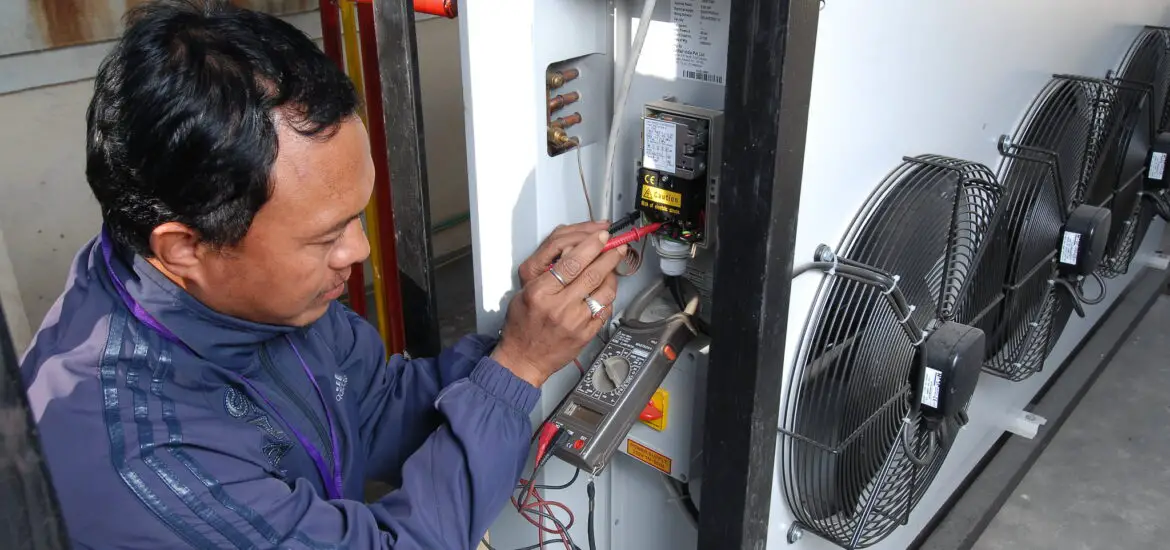If you’re experiencing issues with your air conditioning, you might be asking, “How do you check the freon in your AC?” This comprehensive guide will provide a step-by-step walkthrough so you can determine if your AC unit has the proper freon levels. Let’s get started.

Table of Contents
Can I Check My Own Freon?
Technically, yes, you can check your own freon levels, but there are some important caveats. Freon is a controlled substance, and handling it improperly can be illegal and dangerous. It can cause skin and eye irritation, and if inhaled in large amounts, can lead to serious health issues.
Therefore, while it’s possible to perform a rudimentary check using AC gauges, the following must be considered:
Legal Restrictions: In some jurisdictions, it’s illegal to handle freon if you’re not a certified technician. You can read this article: Is It Illegal To Use Freon? The Ultimate Guide to Freon Laws to find out if it’s legal to use Freon.
Safety Concerns: Freon is a chemical that requires safe handling, including using gloves and goggles, to minimize risks.
Accuracy: Professional service technicians have the training and equipment to measure freon levels accurately. DIY methods can only give you a rough idea.
If you’re not confident in your ability to safely and accurately check freon levels, it’s best to consult a professional.
Tools Needed
To check the freon in your AC, you will need a few essential tools. Make sure you have the following items:
AC Gauges: These are used to measure the pressure levels of the freon in your AC system.
Check out this BENTISM 4-Way AC Manifold Gauge Set from Walmart.
Gloves: You’ll need protective gloves to ensure that you don’t come in direct contact with freon, which can be harmful.
Safety Goggles: These are to protect your eyes from any accidental splashes of freon.
You can get this Walmart-sold Hyper Tough Splash Goggles for this task.
Thermometer: This will be used to measure the temperature of the air coming out of the AC.
How Do You Check the Freon in Your AC?
Here are the detailed steps to guide you through the process of checking the freon levels in your AC system. Each step is designed to be as clear and comprehensive as possible:
Turn Off the AC: The first step is to completely power off your air conditioning unit. Disconnect it from the electrical outlet to ensure your safety.
Put On Safety Gear: Before you even approach the AC unit, make sure you’re wearing gloves and safety goggles. Freon can cause chemical burns or eye injuries if mishandled.
Locate the Service Ports: These are generally found on the refrigerant lines near the condenser unit outside your home. One is for low-pressure (usually labeled as “Low” or “L”) and the other for high-pressure (usually labeled as “High” or “H”). They often have plastic caps for protection.
Attach AC Gauges: AC gauges come in a set with color-coded hoses. Attach the blue hose to the low-pressure port and the red hose to the high-pressure port. Make sure the connections are secure to prevent any freon leakage.
Start the AC: Plug the unit back in and turn it on. Allow it to run for about 10-15 minutes so that the system reaches a stable state. This ensures that your gauge readings are as accurate as possible.
Read the Gauges: Now, check the readings on both gauges. Ideal pressure levels depend on your specific AC unit and the current outdoor temperature. Consult your AC’s user manual for this information. If the gauge shows a reading lower than recommended, you likely have low freon levels. Conversely, a higher reading indicates overcharging.
Check the Temperature: Using a thermometer, measure the temperature of the air coming out of your AC vents inside the home. If the temperature isn’t as low as it should be according to the thermostat setting, it’s another sign that your freon might be low.
Contact a Professional: If any of your measurements or observations suggest that the freon levels are not ideal, it’s time to call a certified technician. They can perform a more accurate test and safely adjust the freon levels if necessary.
Remember, if you’re ever in doubt or concerned about safety, it’s always better to consult a professional for this task.
Why Checking Freon Levels is Important
Freon, or refrigerant, is the substance that your air conditioner uses to remove heat from the air inside your home. It’s the backbone of your AC’s cooling cycle. When you set your thermostat to a cooler setting, freon absorbs heat from the indoor air and releases it outside, thereby cooling your home.
If your freon levels are not adequate, your air conditioner can’t effectively remove heat. This results in a series of problems:
Reduced Efficiency: Your AC has to work harder to cool your home, leading to increased energy consumption and higher electricity bills.
Poor Cooling: Even though the AC is running, you’ll notice that the temperature inside your home doesn’t reach the level you’ve set on the thermostat.
System Strain: Running your AC with low freon puts additional strain on the compressor, which is the heart of the air conditioning unit. Over time, this can lead to system breakdowns and costly repairs or replacements.
Regularly checking and maintaining the correct freon level is crucial for efficient and effective AC operation.